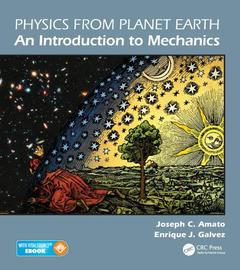Physics from Planet Earth - An Introduction to Mechanics
Auteurs : Amato Joseph C., Galvez Enrique J.

Expose Your Students to the Elegant World of Physics in an Enticing Way
Physics from Planet Earth - An Introduction to Mechanics provides a one-semester, calculus-based introduction to classical mechanics for first-year undergraduate students studying physics, chemistry, astronomy, or engineering. Developed from classroom-tested materials refined and updated for over ten years at Colgate University, the book guides students on a journey beyond standard approaches that use blocks, projectiles, and inclined planes to grander themes involving interplanetary travel, exoplanets, asteroid collisions, and dark matter.
Beginning students are often bewildered by the rapid-fire presentation of physical concepts, mathematics, and problem-solving strategies in traditional introductory textbooks. In contrast, this text:
- Introduces the three conservation laws (momentum, energy, and angular momentum) as fundamental laws of nature from which secondary concepts, such as force and torque, are derived
- Organizes topics around the conservation laws, avoiding the typical "math overload" that confronts students at the start of standard courses
- Motivates and illustrates many topics through real, contemporary applications in astronomy, planetary science, and space travel
After reviewing the basic mathematical tools needed to study mechanics, the text addresses the conservation of momentum and applications, such as gravity-assisted space travel and rocket propulsion. It next discusses Newton?s Laws and numerous space- and astronomy-based applications. The text then presents evidence for a second conservation principle, energy, which allows us to describe motion as a function of position rather than time. The book also explores the conservation of angular momentum and a variety of applications, including pulsars, orbital eccentricity, and gyroscopes. The text concludes with a discussion of dark matter, dark energy, and the ultimate fate of the universe.
Mathematical Toolbox. Conservation of Momentum. Conservation of Energy. Conservation of Angular Momentum. Going Beyond. Appendices. Index.
Joseph C. Amato retired from Colgate University in 2009 as the William R. Kenan Jr. Professor of Physics. He earned a PhD in experimental solid state physics from Rutgers University. He has conducted research in low-temperature physics, accelerator physics, granular materials, and physics education, including the design of novel laboratory apparatus and exercises for introductory physics courses.
Enrique J. Galvez is the Charles A. Dana Professor of Physics and Astronomy at Colgate University. He earned a PhD in physics from the University of Notre Dame. His research interests focus on atomic and optical physics, such as experimental atomic physics with Rydberg atoms, geometric phases in optics, and photon entanglement, as well as physics education, including the development of new quantum mechanics laboratories.
Date de parution : 07-2015
20.3x22.9 cm
Thèmes de Physics from Planet Earth - An Introduction to Mechanics :
Mots-clés :
Deep Space; Inertial Reference Frames; laws of physics; Semimajor Axis; Newton’s Laws; Angular Momentum; conservation of angular momentum; Energy Conservation; orbital eccentricity; Hubble Law; dark matter and dark energy; Gravitational Force; introduction to classical mechanics; Free Body Diagram; exoplanets; Semiminor Axis; three conservation laws; Uniform Circular Motion; momentum; energy; and angular momentum; Hohmann Transfer Orbit; applications in astronomy; Circular Orbit; applications in planetary science; Total Angular Momentum; Centripetal Acceleration; Elastic Collision; Potential Energy Function; Elliptical Orbit; Final Velocity; Galactic Center; Simple Harmonic Motion; Solar System; Cm Velocity; REU Program; Exhaust Speed; dL Dt



